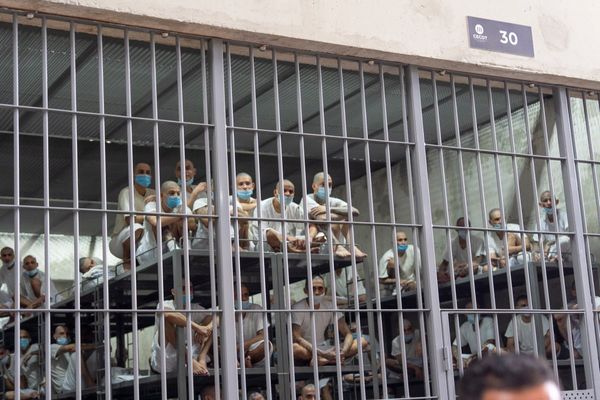KANSAS CITY, Mo. — Darrell Hargraves grew up around gun violence in Kansas City – his best friend was killed when he was 20 – and he went on to serve several stints in prison.
But when the 48-year old was released after an 11-year sentence for a robbery, he was determined to turn things around.
He began a remodeling business in 2009, revitalizing homes on the city’s East Side. The business was doing well and after nearly a decade, he seemed to be on the right track.
But in March 2018, he was arrested while working on a house near Indiana Avenue.
As a convicted felon, Hargraves was not allowed to have a firearm. But he carried a gun in areas he felt unsafe “for my protection,” he said.
Hargraves became one of more than 3,600 people convicted between 2015 and 2021 for federal firearm possession in Missouri, which outranks the rest of the nation for its rate of prosecution of such crimes.
In an analysis of federal sentencing and crime data, The Kansas City Star found Black people were disproportionately convicted for illegally carrying firearms compared to white people. They were also sentenced more harshly.
In the Eastern District, a federal court jurisdiction that includes St. Louis, 81% of those convicted of illegal firearm possession in the past seven years were Black. In the Western District, which includes Kansas City, 54% were Black. Together the two districts cover the entire state of Missouri.
The state’s population is 12% Black.
In the Western District in 2020, Black people were also more than twice as likely to receive sentences above the recommended guidelines for firearm possession compared to white people, according to data from the United States Sentencing Commission.
Don Ledford, a spokesman for the U.S. Attorney’s Office in the Western District, said the office did not have demographic information on gun possession convictions.
“Race is not a factor in prosecutorial decision making or sentencing recommendations,” Ledford said. “Therefore, we don’t track defendants or cases on that criteria.”
But researchers, advocates and community members say when it comes to carrying guns, Black people are treated differently as a result of the structure of the state’s gun policies and uneven enforcement.
“There was certainly a racial politics on who got to carry a gun ... There were African American men who tried to open carry and would get attacked or shot,” said Dr. Jonathan Metzl, author of “Dying of Whiteness” and director of the Center for Medicine, Health, and Society at Vanderbilt University.
“They’re seen as criminals.”
Meanwhile, legislators in Missouri have dismantled state firearm laws in recent years, allowing guns to be more easily purchased, expanding where they can be carried and loosening the ways they can be used, including Stand Your Ground laws.
Hargraves said he wants to see the community be safer.
“I do understand there are individuals that regardless of race are harming people,” he said. “My problem lies … in unfairness, the unfairness in sentencing, the unfairness in prison, the unfairness in not assessing the overall situation.”
Darrell’s story
Hargraves and his best friend Billy Ware were planning on enlisting in the Marines when Ware was struck in crossfire at a convenience store at the corner of 58th and Swope Parkway on Feb. 13, 1994.
He died two weeks later at Research Hospital.
The shooter was a young teen whose bike Hargraves used to fix, he said.
The death of Ware, who Hargraves would later name his son after, was a turning point that solidified what the neighborhood he lived in around 40th and Benton Avenue was: segregated and struggling with gang violence, drugs and cycles of incarceration.
For Hargraves, it was impossible to escape.
He spent the next few decades in and out of prison. His longest incarceration of 11 years came after a jury of 11 white people and one Black woman found him guilty of attempted armed robbery in North Carolina.
Hargraves was released in 2006 and when he returned to Kansas City in 2008, his family said they could see a difference.
“He had started working on his house, he had a lot of jobs lined up, he had really started straightening up and was headed in the right direction,” said Willie Rogers, Hargraves’ brother and a pastor at New Beginnings on Independence Ave. “He wasn’t in all the stuff he used to be.”
Hargraves had taken a variety of courses on electrical wiring and construction while in prison and began putting them to use, working on businesses, mosques, churches and even rehabbed houses that were used by police task forces.
But he was living in an unsafe area, the Santa Fe neighborhood, which has a high rate of shootings in Kansas City.
“The neighborhood he was living in at the time – that area was very bad, you just about have to have a firearm with you at all times to protect yourself,” Rogers said.
In 2012, Hargraves was assaulted while working on a home, he said in a letter he sent to The Star in September 2020, when he was incarcerated in the federal prison in Leavenworth.
He purchased a gun.
“My belief at the time was that I had to protect myself, despite being a violation of the law,” he wrote in the letter. “Self-preservation prevailed, which brings me to where I am today.”
On Oct. 12, 2017, as he was returning home from working in Independence in a new car, he was pulled over by a police officer who said he did not see temporary license tags, Hargraves said. The officer asked him to step out of the vehicle.
“He asked to search the vehicle, and I told him, ‘Fine,’ and complied and told him, ‘I just gotta let you know, I have a firearm in my toolbox,’” Hargraves said.
He was arrested, but then let go.
Convicted and sentenced
Six months later, Hargraves was arrested as a result of the car stop.
He learned the Independence Police Department was part of a joint federal task force which is how the gun possession case ended up in the hands of federal prosecutors.
He pleaded guilty to unlawful possession of a firearm on Aug. 14, 2018, and was sentenced in December 2018 to four-and-a-half years to be served at Leavenworth prison.
“It was heartbreaking because he had started moving forward, trying to make something of his life and trying to have something,” Rogers said. “It seemed like the minute he tried to accomplish something, it kind of backfired on him.”
Hargraves is far from the only one: more people in the state are federally convicted for firearm possession than drug crimes, which is unusual compared to much of the country.
The Eastern and Western districts of Missouri ranked first and sixth, respectively, for the number of people incarcerated for illegal firearm possession in any federal district in 2021. The year before, they ranked first and third.
The rate of firearm possession began to noticeably increase in Missouri’s federal districts in the early days of Project Safe Neighborhood, a U.S. Department of Justice program that began in 2001, said Ken Novak, a criminal justice professor at the University of Missouri - Kansas City.
It brought together federal, state and local law enforcement officials, prosecutors, community leaders, and other stakeholders to identify the most serious violent crime problems in each region.
In Missouri’s federal districts, that was gun violence and homicides, said Novak.
That led to more federal prosecutions for gun violations.
“In order to effectively address gun violence, it’s not going to be one solution. And so certainly, strategic prosecution at the federal level, can be part of that portfolio of solutions,” Novak said. “But I’m skeptical about saying simply, ‘Hey, let’s increase the number of federal prosecutions and that alone is going to have an impact.’”
In 2001, less than 20% of people sentenced for federal crimes in Missouri were convicted of firearm crimes. Twenty years later, 43% of all federal defendants in Missouri were convicted of gun charges.
Nationally, the rate of firearm violations is much lower and grew more slowly: from about 7% of all federal offenders to 14%.
Michael Bradley, law enforcement coordinator for the Eastern District of Missouri, said the district has been focused on addressing violent crime for many years.
However there is little evidence to suggest incarcerating people for firearm possession helps curb violent crime or targets those who perpetrate gun violence in their communities, according to research by legal experts and federal defenders.
In Missouri, the majority of violent crimes are committed by people under the age of 30, according to data from the FBI’s Uniform Crime Reporting program.
Meanwhile, 63% of those convicted for federal firearm possession in the state are 30 or older.
Diane Dragan, a federal public defender in the Eastern District of Missouri, said of the people she has defended for firearm possession, there has been no pattern of previous violent convictions.
More often than not, they felt like they needed guns for their safety, she said.
“A lot of the individuals that are arrested are arrested in areas of town that are known for violence and are known for drug trafficking,” Dragan. “So most people who are carrying guns are carrying them to protect themselves, not to harm others.”
Racial disparities
As a Missouri lawmaker and governor, Mike Parson has advocated for measures that make guns easier to buy, carry and use.
Gun deregulation was pushed forward with white Missourians in mind, said Metzl, the Vanderbilt author.
“There’s a long racial history of gun ownership ... and the NRA and politicians were playing to that — basically saying what it means to be a white man of Missouri is to own and carry a gun,” Metzl said.
“A lot of white men saw it as their socially-sanctioned right to carry a gun and they did, and those men were seen as patriots.”
But it is a different story when it comes to the state’s Black population.
Parson has supported federal operations to remove guns from streets, but those initiatives often focused on cities and communities with more people of color compared to the rest of the state.
Felony firearm possession is often the easiest gun-related charge to prove, said Novak, the UMKC professor, which leads to more prosecutions compared to other crimes.
Laws focused on felons are “racially coded language,” he added, because people of color of are more likely to come into contact with police, more likely to be arrested and more likely to be labeled a felon than white people.
“It’s bias for sure and an unanticipated consequence perhaps. It is not necessarily a conscious discrimination, but it’s reflective of the larger systemic problem we have in the criminal justice system.”
‘I’ll never return to that life again’
While Hargraves was serving time in Leavenworth on the firearm conviction, he joined Reaching Out from Within, a rehabilitation program led by the incarcerated.
The group allowed him to explore how growing up around gun violence impacted him and he also mentored younger men in prison.
In December, Hargraves was released to a halfway house and in March, was able to leave the halfway house.
He is rebuilding his life once again, living with his sister and working as a technician at Jetz Services, a laundromat near Worlds of Fun. He has also begun picking up contracting jobs and started making plans to open up his business again.
Hargraves is glad to be moving forward and said he will never carry a firearm again.
“I know I’ll never return to that life again,” Hargraves said. “Initially I was angry, but now I’m just focusing on family and career … I’m on federal probation and that comes with a certain amount of anxiety, so I’m just trying to focus on building my business, my family and seeing my grandkids.”
But he would like to see accountability from others, namely elected officials who have allowed guns in mass quantities in Missouri.
The gun culture promoted by state lawmakers, Hargraves argued, allowed the Santa Fe neighborhood where he lived to become violent and was then used to imprison him when he tried to protect himself from that violence.
“Yes, there is violence in our community I want us to solve,” he said. “I love this city and I love my community, but that doesn’t mean we have to put everyone with a past, everyone that lives in a certain neighborhood and everyone that looks a certain way into prison.”
———







